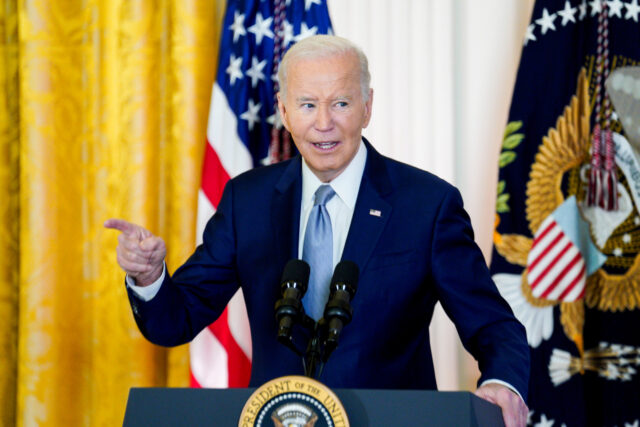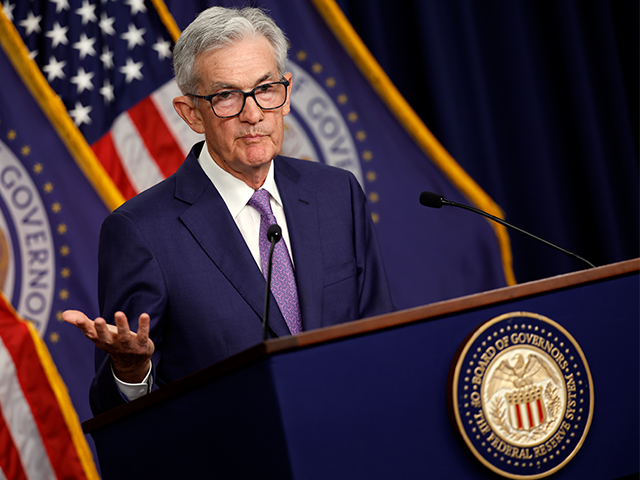from SchiffGold
Stocks Will End 2025 Lower Due to Sticky Inflation, Economic Slowdown, Stifel Predicts
by Josh Schafer
Yahoo! Finance
The stock market will end 2025 lower than its current levels, according to Stifel chief investment strategist Barry Bannister.
Bannister sees sticky inflation prompting the Federal Reserve to hold interest rates high as economic growth weakens, serving as key catalysts to the eventual pullback in the stock market rally. Bannister sees the S&P 500 (^GSPC) ending 2025 in the mid 5,000s. As of Thursday afternoon, the S&P 500 was hovering just shy of an all-time high at about 6,070.
Biden’s Legacy: Producer Price Inflation Jumps Higher Than Expected
by John Carney
Breitbart.com
 Prices paid to U.S. producers of goods and services rose at a rapid clip in November, the latest sign that progress on bringing down inflation has stalled and inflation may be in danger of rising again.
Prices paid to U.S. producers of goods and services rose at a rapid clip in November, the latest sign that progress on bringing down inflation has stalled and inflation may be in danger of rising again.
The producer price index—or PPI—rose 0.4 percent November, the Bureau of Labor Statistics said on Thursday morning. That was one-tenth of a point higher than expected. In addition, the prior month’s figure was revised up from an increase of 0.2 percent to 0.3 percent.
Compared with a year ago, the producer price index is up three percent, the largest year-over-year gain since February 2023.
The PPI measures a basket of prices paid to U.S. producers of goods and services. It differs from the better-known consumer price index but both are measures of inflation. The PPI excludes imports but includes exports, while the CPI does the opposite. PPI also includes prices paid by governments and businesses, two purchasers excluded by the CPI’s narrower focus on consumers.
Inflation May Prove Stickier, Making Deeper 2025 Rate Cuts Less Likely
by Simon Moore
Forbes
![]() The Federal Open Market Committee started cutting interest rates in September and that broad trend looks set to continue. However, fixed income markets now see perhaps only two more cuts in 2025 according to the CME FedWatch Tool.
The Federal Open Market Committee started cutting interest rates in September and that broad trend looks set to continue. However, fixed income markets now see perhaps only two more cuts in 2025 according to the CME FedWatch Tool.
That’s in part as inflation, though cooling overall, is not immediately on track for the FOMC’s 2% annual goal. It’s currently closer to 3%. In addition, the jobs market and economic growth appears to be holding up relatively well on recent reports for November and Q3, perhaps adding a little inflationary pressure, even as unemployment is edging up from low levels.
The Most Insolvent Bank in the History of the World is…
by James Hickman
Schiff Sovereign
 As the 1800s came to a close and the world propelled itself full of innovation and optimism into the 20th century, there was perhaps nowhere else on the planet more admired and envied (except for the United States) than Argentina.
As the 1800s came to a close and the world propelled itself full of innovation and optimism into the 20th century, there was perhaps nowhere else on the planet more admired and envied (except for the United States) than Argentina.
In fact, just like America in the late 1800s and early 1900s, Argentina was overflowing with immigrants from all over the world looking for a better way of life in that land of opportunity.
Argentina had already become a rich country at that point. And it was becoming richer so quickly that its economic growth was outpacing even that of the United States.
By 1900 Argentina’s economy was larger than the rest of Latin America combined, and roughly as large as all of Western Europe combined. It seemed like there was nowhere to go but up.
PPI, “Core” PPI, “Core Services” PPI Inflation Much Hotter After Whopper Up-Revisions Going Back Months
by Wolf Richter
Wolf Street
 The problem is in services, which account for 67% of PPI. But goods prices are re-accelerating too. The whole inflation scenario has changed.
The problem is in services, which account for 67% of PPI. But goods prices are re-accelerating too. The whole inflation scenario has changed.
The prior months’ data of the Producer Price Index were revised substantially higher today, powered by whoppers of upward revisions in the PPI for services, something that has been happening month after month, and on top of that came the price increases in November.
The PPI tracks inflation in goods and services that companies buy and whose cost increases they ultimately try to pass on to their customers. And the entire year 2024 through November has been a big acceleration.
Gold Advances as Inflation Data Fuels Fed Rate Cut Optimism
by Anushree Ashish Mukherjee and Anjana Anil
Reuters.com
 Dec 11 (Reuters) – Gold gained on Wednesday after an inflation print came in line with expectations, boosting the likelihood of a Federal Reserve rate cut next week, while investors awaited U.S. Producer Price Index (PPI) data for further direction on monetary policy.
Dec 11 (Reuters) – Gold gained on Wednesday after an inflation print came in line with expectations, boosting the likelihood of a Federal Reserve rate cut next week, while investors awaited U.S. Producer Price Index (PPI) data for further direction on monetary policy.
Spot gold climbed 0.9% to $2,717.29 per ounce, as of 01:41 p.m. ET (1841 GMT). Spot prices for bullion hit a record high of $2,790.15 an ounce on Oct. 31.
U.S. gold futures settled 1.4% higher at $2,756.70.
The U.S. consumer prices rose 0.3% on a monthly basis in November, data from the Labor Department showed. Annually, it climbed 2.7% after increasing 2.6% in October.
PPI Shows Wholesale Inflation Jumped More Than Expected Amid ‘Extended and Bumpy Journey’ to Fed’s Target
by Josh Schafer
Yahoo! Finance
Wholesale prices rose more than expected in November, adding to a string of sticky inflation prints.
Thursday’s report from the Bureau of Labor Statistics showed that its producer price index (PPI) — which tracks the price changes companies see — rose 3% from the year prior, up from the 2.4% in October and above the 2.6% increase economists had projected. This marked the highest year-over-year increase since February 2023. On a monthly basis, prices increased 0.4%, compared to the 0.2% seen in October.
Excluding food and energy, “core” prices increased 3.4% year-over-year, above October’s 3.1% increase. Economists had expected an increase of 3.2%. Meanwhile, month-over-month core prices increased 0.2%, in line with last month’s rise and economist projections.
Breitbart Business Digest: Inflation is Still a Big Problem and the Fed Could Make it Worse
by John Carney
Breitbart.com
 The Inflation Trend Is Not Our Friend
The Inflation Trend Is Not Our Friend
The Federal Reserve is about to triple down on its September rate cut mistake by reducing its benchmark for a third consecutive time next week.
The federal funds futures market currently implies a 95 percent chance of a Fed cut at the December meeting of the Federal Open Market Committee (FOMC). A 25 basis point cut will bring the cuts in the second half of 2024 to 100 basis points, a significant easing of the stance of monetary policy, despite a strong labor market and stubbornly persistent inflation.
The Department of Labor released its latest read on consumer prices on Wednesday. This showed consumer prices rising at a breakneck annualized rate of 3.8 percent in November, a big step up from the 3.0 percent annualized pace in October. Core inflation also rose at an annualized rate of 3.8 percent, up from 3.4 percent in October.
Beneath the Skin of CPI Inflation: CPI & “Core” CPI Accelerate Further Month-to-Month, Three-Month Averages Heat Up For Fourth Month. Year-Over-Year, CPI Accelerates for Second Month.
by Wolf Richter
Wolf Street
 On re-spiking motor vehicle prices, jumping food & gasoline prices. But housing inflation backs off.
On re-spiking motor vehicle prices, jumping food & gasoline prices. But housing inflation backs off.
The overall Consumer Price Index rose by 0.31% (+3.8% annualized) in November from October, the sharpest increase since April. It has been accelerating since June (blue).
The three-month average jumped by 3.0% annualized, also the sharpest increase since April, and the fourth month-to-month acceleration in a row:
Is Inflation in 2024 Fueled by Supply or Demand?
by William J. Luther
The Daily Economy
 Inflation picked up in October, but remains more or less on track. The Personal Consumption Expenditures Price Index (PCEPI), which is the Federal Reserve’s preferred measure of inflation, grew at a continuously compounding annual rate of 2.9 percent in October 2024. It has grown at an annualized rate of 2.1 percent over the last three months and 2.3 percent over the last year.
Inflation picked up in October, but remains more or less on track. The Personal Consumption Expenditures Price Index (PCEPI), which is the Federal Reserve’s preferred measure of inflation, grew at a continuously compounding annual rate of 2.9 percent in October 2024. It has grown at an annualized rate of 2.1 percent over the last three months and 2.3 percent over the last year.
Core PCEPI inflation, which excludes volatile food and energy prices but puts more weight on lagging housing services prices, was 3.3 percent in October 2024. It averaged 2.8 percent over the last three months and 2.8 percent over the last year.
Pandemics, Hurricanes, Strikes, and Supply Shocks
Why did inflation pick up in October? Adverse supply conditions are at least partly to blame. Hurricane Helene ripped through north Florida, Georgia, the Carolinas, and Tennessee in late-September, leaving those in its wake to deal with debris and high water in the weeks that followed.
